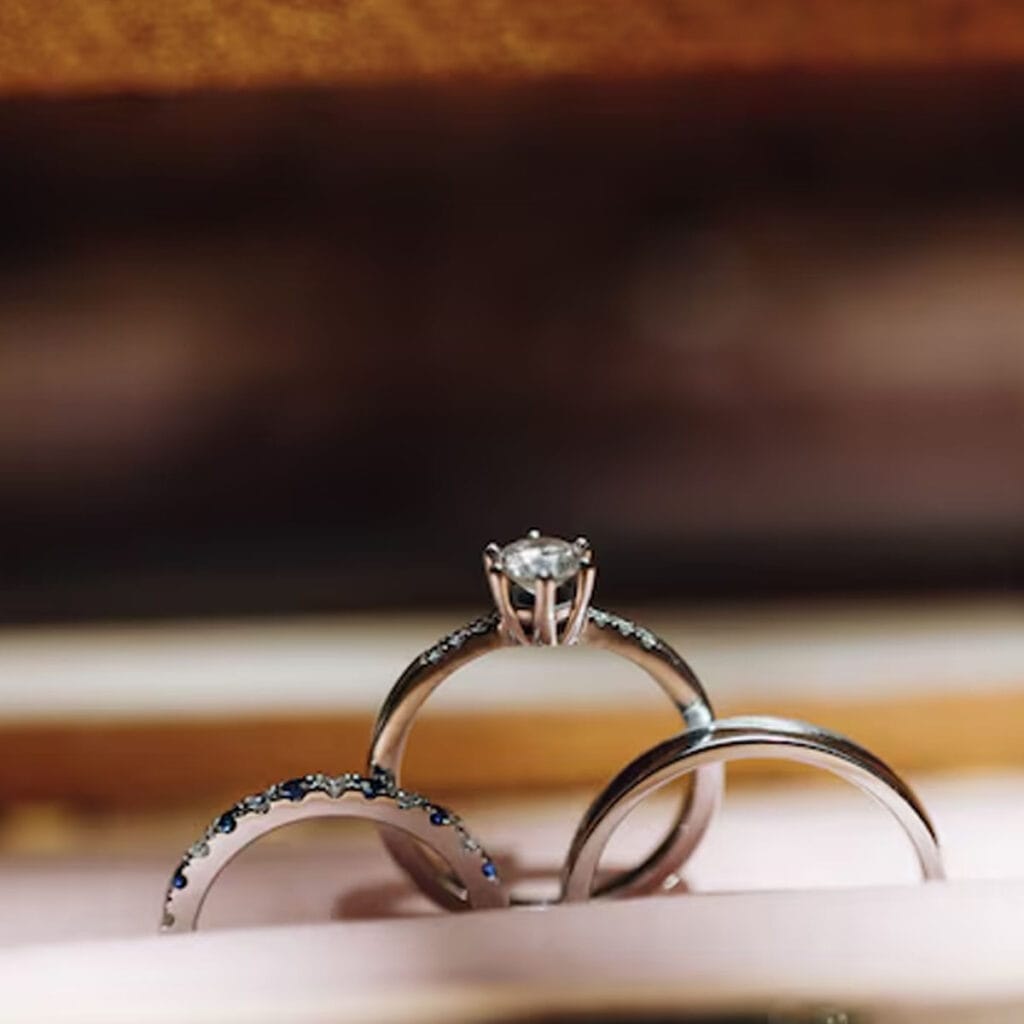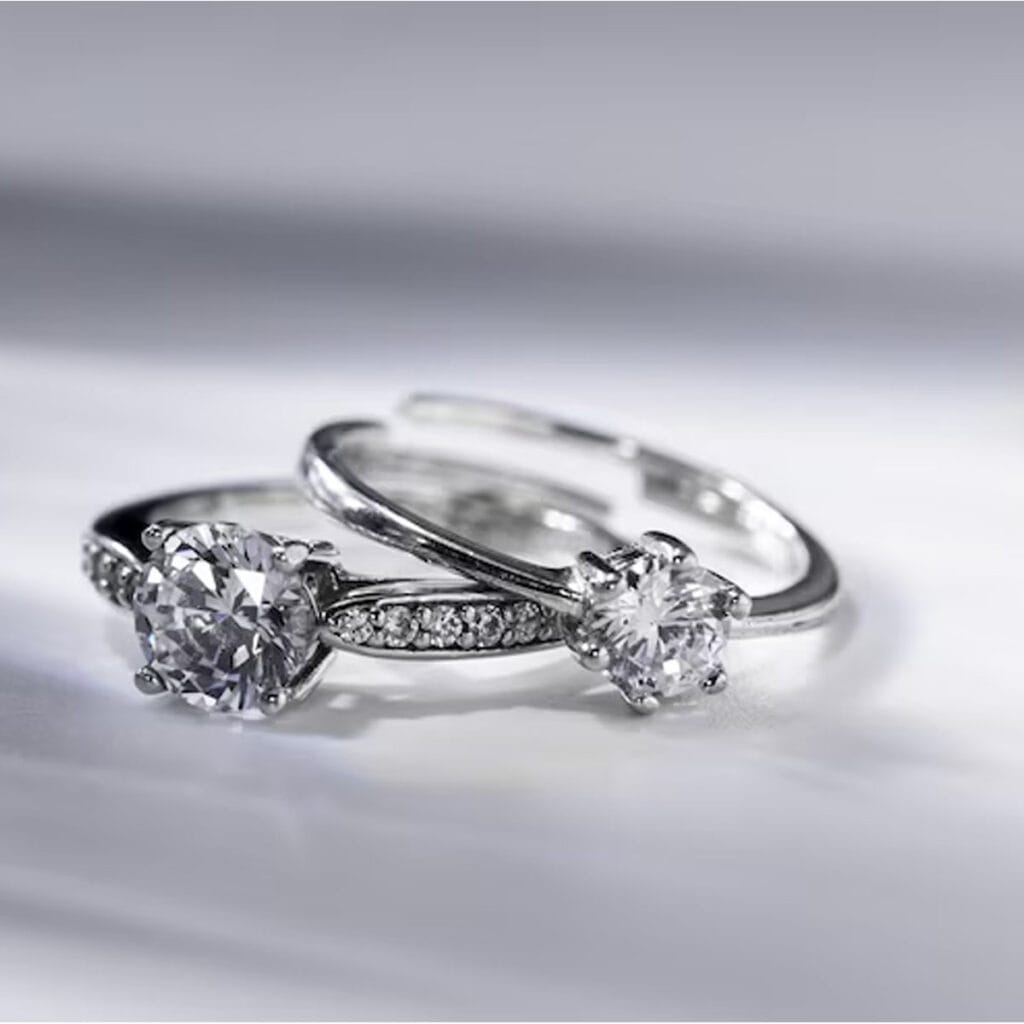A marriage proposal crystallises personal history into a single, dazzling object. In that moment, the engagement ring carries every whispered promise and future plan. Yet the discussion that follows – “How big should the diamond be?” – often rests on guesswork or folklore. For UK couples balancing meaning and money, understanding carat weight is the first step toward an informed, confident choice.
Understanding the Carat Standard
A carat is not a measure of size but of mass. Defined universally at 200 milligrams (0.2 grams), it ensures that a 1.00‑carat diamond bought in Birmingham weighs exactly the same as one bought in Tokyo. Confusing “carat” with “karat”, the purity scale for gold, is a common pitfall.
Gem traders once used carob seeds to test stones because the seeds’ weight is remarkably consistent. Modern laboratories have replaced seeds with electronic microbalances capable of reading to the fifth decimal place. For retail purposes, the Gemological Institute of America (GIA) rounds that figure to two decimals with ironclad rules: only a terminal 9 in the thousandths place rounds up. Thus 1.128 carats reports as 1.12, but 1.129 carats becomes 1.13.
Fun Fact: In ancient markets, a merchant’s box of carob seeds functioned as today’s digital scale – proof that the quest for accurate diamond weighing predates electricity.
Every carat divides into 100 “points”. A jeweller may describe a 0.75‑carat diamond as a 75‑pointer. This vocabulary underpins pricing tables and helps shoppers compare stones below one carat with precision.
Weight and Size Are Not Synonyms
Many buyers equate weight with size, yet carat measures mass, not face-up area. Two diamonds of identical weight can look strikingly different because of cut proportions. A stone cut too deep hides weight in its pavilion, shrinking the visible diameter. A well‑cut diamond spreads its mass efficiently, presenting a broader surface and stronger light return.
Shape compounds the effect. Elongated profiles such as Oval, Pear and Marquise carry more table area per gram than a Round Brilliant. Consequently, a 1.00‑carat oval often looks about 10 percent larger than a round of the same weight – one reason ovals’ share of UK sales jumped from 23.9 percent to 33 percent in 2024.
Carat Within the 4Cs
Carat is one pillar of the GIA’s four-part grading language, alongside Cut, Colour, and Clarity. Larger stones are rarer, so the price climbs sharply with weight, but beauty depends on the quartet acting together. A smaller diamond with an Excellent cut, high colour, and eye-clean clarity can outperform, in sparkle and value, a larger stone lacking those qualities. As the American Gem Society notes, judging a diamond solely by size is like valuing a painting only by its canvas dimensions, not the artistry.
Typical UK Buying Patterns
Market data places the average UK engagement ring between 0.6 and 1.0 carats. London jeweller Queensmith reports an average clientele of 1.25 carats, yet national figures trend closer to the 1.0-carat line. Across the Atlantic, the US buyer tends to lean larger, while mainland Europe and China lean smaller, closer to 0.5 carats. One British shopper with a 0.8-carat diamond recalled that US friends called it “standard” and a UK parent called it “huge” – a glimpse into how social context shapes perception.
Regional and Generational Trends
Londoners typically favour heavier stones, around 1.25 carats, reflecting urban incomes and exposure to luxury retail. Rural and smaller-city shoppers often choose between 0.50 and 1.00 carats. Meanwhile, younger consumers are rewriting the script. Almost half of UK buyers aged 18‑34 would consider lab‑grown diamonds, attracted by savings of 60‑85 percent versus mined equivalents. That budget stretch produces bigger average carats among the under‑35s, pushing national statistics upward even as traditional spending patterns persist elsewhere.
The Psychological Pull of One Carat
Crossing the 1.00‑carat threshold confers symbolic weight beyond mere milligrams. The “one‑carat club” is viewed as aspirational, and that perception fuels a dramatic price jump at exactly 1.00 carat. Understanding this jump equips shoppers either to embrace the milestone or to consider the savings of a 0.95-carat stone that the naked eye cannot distinguish.
Diamond Shape Influences Perceived Size
Certain outlines create instant impact:
- Oval, Pear, Marquise – elongated forms maximise table area, appearing up to 10 percent larger than rounds.
- Round Brilliant – offers unrivalled symmetry and sparkle, while also showing size honestly.
- Princess, Asscher, Cushion – deeper cuts concentrate weight below the girdle, so face‑up size seems modest for the same carat.
Shapes That Appear Largest
- Oval
- Pear
- Marquise
Shapes That Appear Truest to Weight
- Round Brilliant
- Emerald
Shapes That Can Seem Smaller
- Princess
- Asscher
- Cushion
The Power of the Setting
A ring’s architecture can amplify or mute a diamond’s presence.
Size‑enhancing settings
- Halo: A circle of pavé stones can add the visual equivalent of half a carat.
- Hidden halo: sparkle from the side, discreet from the top.
- Pavé band: leads the eye toward the centre stone, enlarging perception.
- Cathedral: arches of metal lift the diamond, increasing prominence and light entry.
- Slender band: contrast makes the diamond look larger.
Other smart choices
- Bezel: a rim of metal outlines the stone, boosting the outline and security.
- White metal: platinum or white gold reflects light, blurring the diamond’s edge and expanding its apparent size.
Carat‑to‑Millimetre Guide
| Carat | Round Ø | Oval L × W | Pear L × W | Princess L × W |
| 0.50 | ~5.1 mm | ~6.5×4.5 mm | ~7.0×4.5 mm | ~4.4 mm |
| 0.75 | ~5.9 mm | ~7.0×5.0 mm | ~7.8×5.0 mm | ~5.0 mm |
| 1.00 | ~6.4 mm | ~8.0×5.5 mm | ~9.0×5.5 mm | ~5.5 mm |
| 1.50 | ~7.4 mm | ~9.0×6.5 mm | ~10.0×6.5 mm | ~6.3 mm |
| 2.00 | ~8.2 mm | ~10.0×7.0 mm | ~11.0×7.0 mm | ~7.0 mm |
Dimensions are approximate; cut proportions cause slight variation.
Budget‑Smart Strategies for Size and Sparkle
Diamond prices do not rise in a neat straight line. They follow a steep staircase, with the sharpest climbs at the so‑called magic sizes of 0.50, 1.00, 1.50 and 2.00 carats. Understanding those ledges turns budgeting into a game of precision rather than sacrifice.
The “buy shy” tactic
Selecting a stone that falls just under a milestone weight secures almost the same visual presence for significantly less money. A high‑quality 0.90 carat natural diamond can cost £4,900–£5,500, while an otherwise identical 1.00 carat stone often commands £6,200–£7,800. The saved funds can elevate Cut from Very Good to Excellent or raise Colour from H to G, upgrades that deliver far more sparkle than a barely perceptible 0.10-carat difference.
Stretching the budget with lab‑grown
For buyers who value size over geological provenance, lab‑grown diamonds redraw the price map. Because laboratory production bypasses costly mining and intermediaries, prices run 60–85 percent lower than for mined stones. A 1.00 carat D‑colour, VS2 lab‑grown diamond typically lists at £1,800–£2,500. That same budget might only reach 0.30‑0.40 carat in a mined D‑VS2.
| Carat & Grade | Natural Price | Lab‑Grown Price |
| 1.00 ct D VS2 Excellent | £8,000–£9,000 | £1,800–£2,500 |
| 2.00 ct D VS1 Ideal | £30,000+ | £3,880–£4,600 |
Prices fluctuate with market conditions, but the ratio stays consistent.


Balancing the 4Cs: Cut First, Carat Last
A diamond’s beauty springs from light, and light obeys physics, not fashion. Cut quality governs how efficiently that light returns to the eye, so it should claim first position in the budget hierarchy.
- Cut – Secure an Excellent (or Ideal) grade wherever possible. This single choice amplifies every pound spent elsewhere.
- Clarity – Aim for eye‑clean. In brilliant cuts, VS2 or SI1 often looks flawless without paying for the label “Flawless”. Step-cut shapes expose inclusions more readily, so VS1 or better is safer in this setting.
- Colour – G to J can appear icy white when set in platinum or white gold. Yellow or rose gold masks faint warmth, making H or I entirely practical.
- Carat – Allocate the remaining budget once the other three Cs meet their target levels.
Following this order often steers couples toward a stone such as 0.92 ct, H colour, SI1 clarity, Excellent cut: smaller on paper than 1.00 ct J SI2 Good cut, yet brighter, cleaner and in many cases better value.
Lifestyle and Long‑Term Practicality
A ring is not an ornament for special occasions; it is an everyday kit. Carat weight, therefore, must reflect the wearer’s routine, not just their aspiration.
Daily wear considerations
- Comfort zone: 0.70–1.25 carats generally supplies presence without snag risks.
- Secure settings: A six-prong, bezel, or channel mounting shields the girdle more effectively than a four-prong head.
- Shape durability: Round, Oval and Cushion corners resist chipping better than sharp points on Marquise, Pear or Princess stones.
Engagement ring insurance
Most UK home contents policies cap single-item claims at £1,500–£2,000. Anything dearer must be listed separately, raising the premium. Specialist jewellery insurance offers worldwide all-risks coverage, often with zero excess, but the cost scales with the valuation. Reputable jewellers recommend:
- Professional valuation on purchase, refreshed every two years
- Photographs and original certificates are stored digitally
- A certified safe for pieces above a specified value, if required by the insurer
Ethical Choices and Market Transparency
Lab‑grown diamonds have not only lowered price barriers; they have also prompted fresh questions about environmental impact, resource provenance and consumer values. While the carbon footprint debate remains complex, the immediate consumer benefit lies in transparency.
Certification is non‑negotiable
Whether the stone formed in the earth or a reactor, insist on a grading report from an independent laboratory.
- GIA has set global standards for consistency in natural diamond grading since the 1950s.
- IGI issues clear, detailed reports for both mined and lab-grown stones, and dominates the laboratory-created segment.
Certificates confirm Cut, Colour, Clarity and Carat, protecting against misrepresentation and anchoring insurance valuations.
Future‑Proofing the Ring
Beyond the initial spark of engagement, life continues to evolve.
- Resizing potential: Plain shoulders allow easier adjustment than pavé‑set bands.
- Maintenance: An annual professional check keeps prongs tight and brilliance high.
- Upgrade paths: Some jewellers offer trade‑up schemes, crediting the original diamond’s price toward a larger stone on milestone anniversaries.
Action Plan: Your Decision Checklist
Discuss each point together before visiting a jeweller.
- Budget ceiling – Agree a firm total for diamond and setting.
- Natural or lab‑grown – Decide which origin aligns with your values and pocket.
- Lifestyle fit – Consider work, hobbies and how often hands meet hard surfaces.
- Personal style – Minimalist or statement? Solitaire or halo?
- 4Cs priority – Rank brilliance, size, colourlessness and flawless look.
- Hand proportions – Try on various shapes to test finger coverage.
- Insurance costs – Check premiums for your chosen value bracket.
- Certification – Commit to GIA or IGI documentation only.
- In‑person viewing – Inspect stones under natural light, away from showroom spotlights.
Ticking each box turns what can feel like a high‑pressure purchase into a confident, measured investment.
Conclusion for Carat and Commitment
An engagement ring speaks louder than its statistics. A well‑cut 0.90 carat diamond can flash brighter pride than a poorly cut 1.20 carat; a modest stone chosen with thought will age better than a lavish one chosen for applause. Focus on enduring comfort, genuine sparkle and the story you both wish to tell. When head and heart align, the diamond becomes more than weight and width; it becomes a daily reminder that, like the stone itself, strong love endures pressure and keeps its light.
As the old saying goes, “Good things come in small packages,” yet the point is never size alone. It is how wisely that size was chosen, how carefully it was set and how proudly it will be worn.

